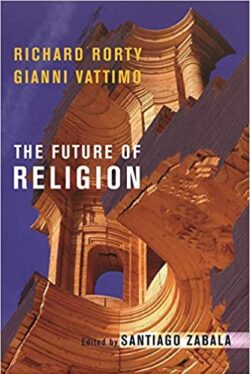Religion of the Future: Art and Metaphor
Religion of the Future: Reclaiming the Subjective Pole by Art and Metaphor.
Organized religion is declining in the western world. Not only is the decline due to the failure of past theological and philosophical systems, but also to the successes of science in competing with religious traditions in describing the world. A religion of the future must come to terms with the place of science in describing the universe. This includes the philosophic assumptions about reality as well as how we understand humanity in the universe…
Living in the world is more important than knowledge. Religion as an art form contributes to the expression of such values. Characterizing such values as artistic or metaphoric expressions, avoids confliction with scientific theories and discoveries. Science progresses by building on past discoveries and is judged by that progress. The greatest artistic expressions, including religious, may have been composed in the distant past. The difference lies in specific understandings of human life and the wider universe. There is a different modus operandi. Humans live richly by metaphors, not heartless and value neutral scientific theories.
What About Science Vs Religion
Both science and religion are responsible for creating confliction between them, religion by denying the legitimacy of a naturalistic non-contradictory scientific approach to the world which tolerates no contradictions or false facts; and science by separating the material world from mind, or subjectivity, which results in depreciating what gives the emotional richness to human life, including spirituality.
Interpretations of quantum physics changed the deterministic nature of the micro world and allowed for freedom and creativity, humanly expressed as the operation of free-will. Restoring mind to the material universe by mutual measuring among subatomic particles changes the traditional idea of material. In addition, the cognitive sciences have argued for the metaphoric nature of all language including scientific language. Thus, a window has been opened to view how metaphors in both the arts and science operate in the real world.
Science tended to view the universe metaphorically as a machine, and following, humanity as a part of the universe also as mechanical. Religion retained a belief in an “other” or transcendent aspect of the world, commonly expressed in the Judeo-Christian faith with regard to human kind, as being “in the image of God,” or the universalizing metaphor of “Incarnation.” Metaphors, in themselves, are neither true nor false; rather their strength is in what they evoke.
Religion of the Future: Metaphors
Although the approach to scientifically associated metaphors differs from that of religion which is artistic, the ingredients were in place to allow for a new understanding of religion, one which is artistic and metaphoric in nature. Humans were co-creators in a creative universe, which increasingly becomes more “wonder-filled” and mysterious with scientific discovery. With the critical demonstration that mind is never eradicated by objectivity, scientific objectivity was nudged, largely through quantum physics, to readmit mind to the universe it investigated.
In science, the universe as machine metaphor is hard to shake off. If we promote this metaphor, the work of science relative to humanity will be algorithms and robotics. The future is up for grabs. Religious or spiritual metaphors play into artistic expressions of what it means to be human, to love, and be creative in art and morality, and to create religions. But science viewing the brain, as it does the universe, from the outside, depreciates mind, consciousness, and a sense of the spiritual, as an attribute of an imperfect machine, the brain.
As a machine, human beings are believed capable of improvement by computerization and robotics. Thus the future of human beings does not lie in flesh and blood bodies that relate to each other as artistic bodies, but in algorithms of extreme machines that can reproduce themselves. This view is basically genocidal. It is sometimes called the Technological Singularity, reflecting on the Big Bang as the place where everything begins. Computers and robotics replace humans as the creators of art and values.
Man as Co-Creator
The metaphor of man being created in the image of God gifts man as a “co-creator,” thus man co- creates the image of God inclusively; patriarchy is overcome not only by including women, but the whole of what human beings may create and understand themselves to be in a universal environment, including the values of justice, mercy, and grace, not only to each other, but the entire living world.
A religion of the future must concentrate on what matters most to human beings; anything constituting a claim on reality beyond the emotional power that defines these human values must be put aside as of lesser importance. Doctrines that nit-pic particular interpretations of scripture, or that coerce individuals to believe a fixed way, external to the things that matter most to human beings, must be allowed to fade away. Likewise, glorifying science and technology, while valuable, does not qualify for the things that matter most to human beings. Rocket technology is not what human beings value most.
No religion can be considered superior to any other as a starting point; creativity demands a universal matrix in which to grow. Every religion will have to examine its metaphors in a context of diversity of cultures and societies to understand how they differ, and how they may coexist creatively and inclusively. But objectivity is not the primary means of this evaluation; this is an artistic and collaborative effort grounded in the mystery of what it means to be human, and what matters most for human life. In a sense we may refer to Kauffman’s understanding of Kantian Wholes: “the parts exist by and for the good of the whole, and the whole exists by and for the good of the parts.”

Joe Greig, Ph.D.
Ph.D. (New College, Edinburgh University), Professor Emeritus Andrews University, Berrien Springs, MI


July 18, 2021 @ 6:04 pm
I like this site very much. But I’m not sure of how you step into religion as art. As a scientist, in Chemistry we search to understand how chemical processes initiated life. We attempt to recreate the foundational components and conditions to see if we can capture evidence of how chemical reactions produced the building blocks of life.
We recognize that life is cellular. One simple definition of life. Getting to that simplicity, you come down to the basic aspects of what is life, this makes it difficult to accept more traditional notions of god and religion.
Where I think the SDA Church fails is by not seeing that spiritual life and connections are warranted in our society. So much so that moving away from traditional thinking will preserve the church. I don’t miss religion as such but at times I miss fellowship. Which right now is impossible although many of my long time friends and my family on both sides are all SDA. So technically the only thing worth preserving from my old way of religious life would be those close ties which I find I’m having to let go.
But I wonder is seeing religion as art and metaphor to difficult for most to gasp? How could these ideas be presented in more manageable pieces?
I’m willing to explore a more metaphorical approach to religious life. After all, as you said a religion of the future has to look at what matters to most to us. To look at how we live and be inclusive of science.
July 23, 2021 @ 4:31 pm
Thanks. I’ll address life first. I don’t think life itself means much without what makes it meaningful to us. As to its origin, I am familiar with two important books: A World Beyond Physics, but Stuart Kauffman, and Every Life is on Fire, by Jeremy England. Kauffman’s approach is by autocatalytic sets, England looks to thermodynamics and develops the theory of dissipative adaption. I wish them well because both their works seem to be aimed at recapturing a sense of the sacred. As you have discovered I argue that metaphoric language is best suited to address the unknown, in fact the only way. I understand metaphor and art in a broad inclusive sense. Religion as metaphor and art, avoids the the problem of falsification. The idea that metaphors are neither true or false, rather evocative, directs attention to how they function in giving meaning to human living. We must recapture the subjective pole while accepting science, but not scientism, as a legitimate approach to the world. A religion of the future and an Adventism of the future suggests, if not demands, that we move away from traditional thinking to creativity, expressing what subjective human strata underlie doctrinal expression. This creativity maximally addresses a worship of the future. The altar informs the pulpit. By that I mean that worship addresses the unknown to inform the known. Adventists are generally reluctant to credit emotive expressions as having anything to do with doctrinal knowledge. Worship is an art form, the worshiping church of the future is one that grasps the meaning of life in time and space artistically. Worship is where we experience an epiphany, a flash of insight, a conversion, a sense of being Woke. Fellowship emerges viewing each other as art forms, motivated by love, itself an artistic creation of relationships. I’m presently talking to artists of all kinds about the place and content of worship.